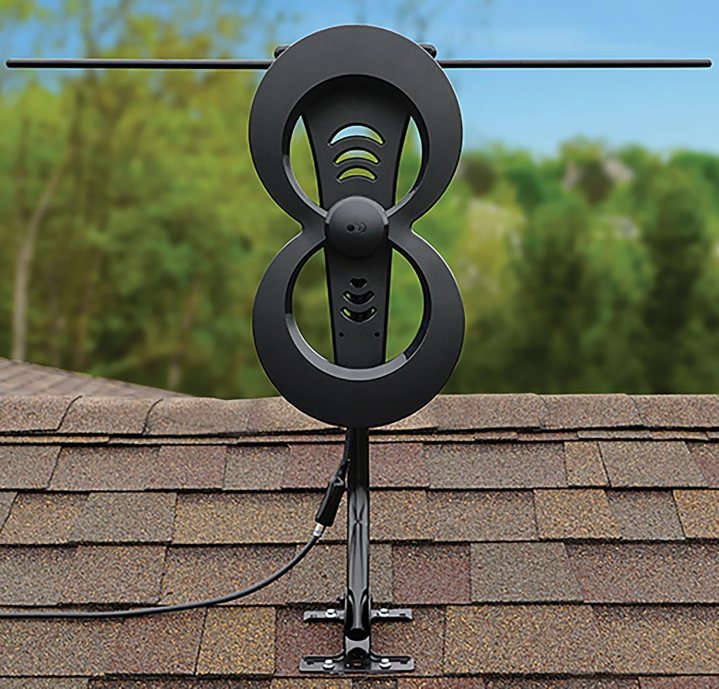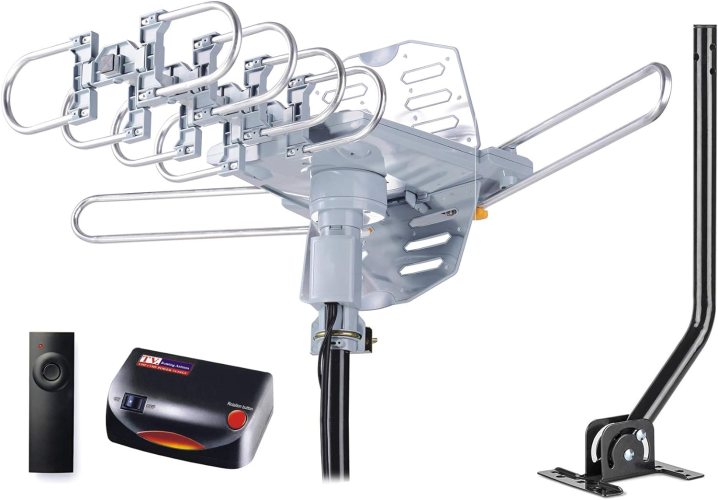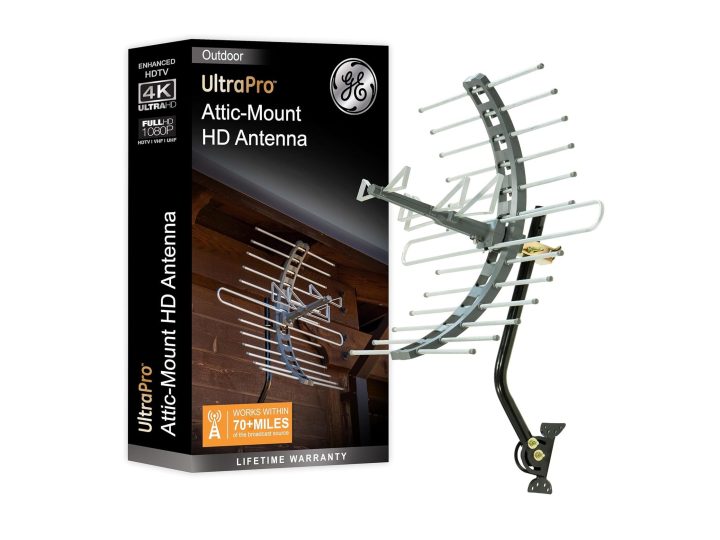It’s not a secret, if you live in a rural area, you’re likely underserved by the most popular cable, internet, and live TV streaming services. TV antennas, however, will let you pick up signals from far away, with the result being consistent, free programming. And with the advent of ATSC 3.0, which brings in higher definition pictures and improved features to over-the-air broadcasting, now is as good a time as ever to get an antenna. So much so that our A/V section editor has, somewhat anachronistically, been telling us that you finally need to get an antenna in 2024.
Yet still, the world belongs to urbanites. Admittedly, many of our picks for the best TV antennas are indoor only, or don’t have the power to get broadcast signal as far as you might need it from your rural home. Here, we’re taking a better look at those that do work best for rural areas and places otherwise underserved by the modern titans of entertainment. We’ll present a quick list of the best TV antennas for rural areas, followed by an in-depth look at why each one will serve your home well, and then finish off with insights into our reasoning for why we selected these TV antennas.
The best TV antennas for rural areas
- Buy the
for a powerful, long-range antenna with everything you need to use it. - Buy the
for a cheaper, but slightly less powerful alternative that is still suitable for many areas. - Buy the
for a yagi antenna with great control. - Buy the
for a great unidirectional antenna. - Buy the
for a multi-use antenna that can mount to the side of your wall or balcony. - Buy the
for a surprisingly cheap antenna with good durability.
Antennas Direct ClearStream 4MAX Kit
Best complete kit with great performance
| Pros | Cons |
| Includes 3-way splitter, coax cable, and other essentials | An expensive kit |
| Has amplifier switch | |
| Simple bracket mounting |
To get started simply with a quality TV antenna, consider this kit from Antennas Direct. It includes a TV antenna that can be mounted to your roof with a simple bracket design, a 30-foot coaxial cable to transport what it receives to your home, and a splitter for up to three TVs to enjoy the entertainment at once. In other words, this is a good pick for everyone in the family to enjoy over-the-air programming, wherever they are in your home.
The Antennas Direct ClearStream 4MAX weighs under three pounds and relatively easy to transport to your roof. It has a simple bolt-and-bracket mechanism for attaching to your roof, and all of the essentials — such as a 30-foot coaxial cable to port what it receives down into your home — are included in the packaging. As a result, we quite like this one. It doesn’t take an expert to get all of the appropriate and compatible wires and other equipment to make the experience great. You’ll also get extras, like an amplifier switch, which makes amplification (a sometimes-beneficial option for modern TV antennas) a snap. All-in-all, this kit is going to be on the expensive side, but that’s because it has everything and is rather powerful.
| Key Specifications | |
| Estimated range | 70 miles |
| Channel reception | Hi-VHF, UHF |
| Size | 17.4 x 31.3 x 4 inches |
| Weight | 2.7 pounds |
Antennas Direct ClearStream 2MAX
Best runner-up

| Pros | Cons |
| Sturdy, quality build | Not a full kit |
| Decent reception range | |
| Simple bracket mounting |
As a sort of “downgrade” to the Antennas Direct ClearStream 4Max, the 2Max variety is just fine for many people. It has a 60 mile effective range, only slightly lower than the previous, but a considerably lower profile and cost than the 4MAX version. The main reason for this is that it is not the full kit that you can get with the 4MAX, so if you know what you’re doing or are willing to shop around, you’ll be able to save quite a bit of money. Furthermore, skipping out on extras like the splitter might save you quite a bit of money on superfluous extras that your home doesn’t need.
Otherwise, many of the features will be the same. The installation should be quite similar with a bracket-and-bolt design. There’s also a 20-foot mast (an upwards-facing pole) that comes with the kit for easy installation and to give you a bit of extra height. At a total of less than two pounds, anybody comfortable with ladders and climbing should be able to transport this to the roof. Finally, it is worth noting that this product has a lifetime manufacturer antenna warranty, so even though it doesn’t appear to be too tough, it should last you for the long term.
| Key Specifications | |
| Estimated range | 60 miles |
| Channel reception | Hi-VHF, UHF |
| Size | 17.4 x 31.3 x 4 inches |
| Weight | 1.9 pounds |
PBD WA-2608
Best yagi antenna

| Pros | Cons |
| Includes remote rotation | Rotation requires occasional readjustment |
| Lightning protected | |
| Supports two TVS without splitter | |
| Includes 40-foot coaxial cable |
If you can collectively decided on what to watch as a family, you may find that you’d like to “aim” at the broadcasting tower directly. While most TV antennas are capable of bi-directional reception gathering, getting most signal around you, a yagi aims in a uni-directional way. The PBD WA-2608 aims at whatever station you want, even when the stations you want are in multiple directions around you. For example, if the PBS station is to your North and the FOX station is to your South, you can press the red rotation button until the PBD WA-S608 points Northward to get PBS, then press and hold the button again until it points Southward to pick up FOX. You might find that you occasionally need to readjust your aim, but once you get used to it, the whole process should be relatively smooth.
The PBD WA-2608 is lightning protected and comes with a 40-foot RG6 coaxial cable that is able to connect well with the antenna and receiver. You’ll appreciate its ability to support two TVs without additional splitting required. It’s easily bolted to the roof and can be placed on the side of the wall as well, but that configuration will reduce the efficacy of its 360-degree rotation, so we don’t recommend it.
| Key Specifications | |
| Estimated range | 150 miles |
| Channel reception | VHF, UHF |
| Size | 17.5 x 13 x 14.5 inches |
| Weight | 6.4 pounds |
Five Star Yagi Antenna
Best uni-directional

| Pros | Cons |
| Weather protections included | Max range somewhat overstated |
| Great uni-directional design | No rotation button |
| Includes 4-way splitter |
The Five Star Yagi Antenna is probably the best TV antenna for you if you live in a rural area just outside of the city limits of a place with many broadcasting stations. It’s point-and-shoot yagi antenna design does not move easily or remotely, but once you have the proper aim lined up, you’ll be able to get a great reception for those key stations. There’s even a 4-way splitter included, so the whole family can enjoy great programming in separate rooms.
Five Star states a range of 200 miles for their yagi antenna, which we assume is a somewhat theoretical range. In reality, the curvature of the Earth will likely prevent you from getting a full 200 miles except under very specific situations. This all being said, real customer reports and experiences with the Five Star Yagi Antenna from all over the glob are quite positive, including with the range. The only real negative for this design is, again, its lack of control in directionality. But, if you’re in the kind of situation where all of the main broadcast stations are generally coming from one area, this TV antenna is a great way for you to maximize your chances of getting great reception.
| Key Specifications | |
| Estimated range | 200 miles |
| Channel reception | VHF, UHF |
| Size | 17 x 8 x 6 inches |
| Weight | 5.54 pounds |
Antop AT-800SBS
Best for apartments

| Pros | Cons |
| Multi-modal installation | Large and bulky |
| Includes VHF Enhancer Rods | |
| Also picks up FM radio |
While we expect most rural TV antenna users to be living in a home or other dwelling with rooftop access, we also know that isn’t always the case. The Antop AT-800SBS is the best TV antenna for rural areas if you’re not a homeowner. It has so many great ways that it can be mounted. While rooftop, side-of-the-wall, and even indoor options are available, there is a choice that we think you’ll really appreciate — balcony mounting.
The Antop AT-800SBS has vertical and horizontal “mast bars” that can quite easily be affixed to the bars of your balcony’s perimeter. While this will naturally limit your reception capabilities to the generalized direction that the TV antenna is facing, it is certainly better than nothing and not a fault of the antenna itself. You can alternatively attempt to place it outside of or even inside of a window, but before you place anything outside of your unit (even on the exterior of your balcony wall) be sure to contact your property manager or, at the very least, check your lease. Note, also, that the Antop AT-800SBS is somewhat heavier and bulkier than you might first expect, so be sure to check out the dimensions before you get creative.
A final word while we’re discussing the capabilities of the Antop AT-800SBS, it can handle FM radio, too! This means that if you’re getting a TV antenna for emergency preparedness, you can use it to get both television news and those all-critical FM news broadcasts. Just makes sure you have a portable power station and enough shielding to have the device weather through whatever storm you’re facing.
| Key Specifications | |
| Estimated range | 85 miles |
| Channel reception | VHF, UHF, FM radio |
| Size | 23.79 x 11.2 x 6.82 inches |
| Weight | 8.28 |
GE Outdoor UltraPro
Best budget

| Pros | Cons |
| Very low cost | Somewhat difficult installation |
| Surprisingly durable | |
| Lifetime warranty |
If you want to go all in on the free entertainment aspect of TV antennas, check out GE’s Outdoor UltraPro antenna, which can be mounted outside or in your attic (as shown on the box). It has a large body with a durable construction, though it is at least partially made of plastic. That being said, GE gives it a lifetime warranty, so we expect the long-term durability and usage to be quite high. A bit of wind won’t rip it apart.
The surprising low point for the GE Outdoor UltraPro is not range, which rocks out at 70 miles, but rather the difficulty in its assembly. While paper instructions are included, the paper they’re on is tiny, and hard to read. Taking your glasses up on the roof, flipping through the pages, and then having a quick burst of wind sending the manual a mile down the road could be a nightmare. Either take pictures of the pages on a low-cost tablet and take that up with you, or do as much pre-assembly as you can before ascending your ladder.
| Key Specifications | |
| Estimated range | 70 miles |
| Channel reception | VHF, UHF |
| Size | 29 x 15 x 20.5 inches |
| Weight | 3 pounds |
How we chose these TV antennas for rural areas
What matters to you, as a person living in a rural area, when you buy a TV antenna? Obviously, individuality matters, and it is no way fair to make large-scale assumptions about your wants or needs. However, there are some consistent features of the environment and infrastructure that are worth considering when making a selection of TV antenna. All of our selections for the best TV antennas for rural areas, above, were made with most or all of the following assumptions in mind.
You have fewer nearby broadcasting stations
The vast majority of broadcast centers are going to be centered near cities. They have resources for employees, a vast customer base, and the opportunity to make the most money. And, even should there be a broadcast station near you, there is probably only one or perhaps two. You can check your home out for yourself via the FCC’s DTV Reception Map database, though to get a better picture of what’s going on in your location.

On the website, you can click each station to see where it is located relative to your position, including how many miles away it is and a direction (useful for when you want to point your antenna directly towards it for the best possible reception). It is also useful to pay attention to the band listed, where you’ll see UHF, Lo-V, and/or Hi-V. These refer to the UHF and UHV bands that your antenna will advertise being able to find.
Taking these factors into consideration, we looked for TV antennas that have at least 40 miles of estimated range, but more was always considered better for rural customers. Additionally, antennas that supported both UHF and UHV were most preferred. Your local circumstances will let you know if you can get by with one or the other band. Any ability to rotate the antenna remotely was considered positive. Note that we have mixed feelings about amplification, which — as the word implies — amplifies signal. It does not refine said signal. So, if a signal is fuzzy, the amplified version could very well be fuzzier.
You have roof access
Home ownership (or rental) tend to be quite high in the US at large, and the census reports that homeownership rates are highest in rural America. As such, there is a broad assumption that you have access to a roof, trailer-top, or even van top. As such, we’re looking at outdoor antennas. If you’re an apartment dweller in a rural community, you can try an indoor antenna, but you also might be out of luck. Discuss your entertainment situation with your property manager before proceeding.
While we’re on the topic of the roof and being outdoors, it is worthy to mention that we understand the diverse environments of rural areas. The tree coverage and branch proximity to your rooftop — which can present challenges to both reception-getting and the health and integrity of your antenna — are going to be largely different in the rural areas 40 miles from Topeka, Kansas and those 40 miles from Knoxville, Tennessee. Likewise, weather and wind will differ in these areas. At the same time, winds can be stronger and the likelihood of being hit by a branch in a storm are naturally larger in these areas.
Taking these factors into consideration, we looked for outdoor antennas that have high durability and varying profiles of size. A decently long warranty with good coverage was also worth looking into. Any factors that gave the antenna weather protection were considered highly positive.
You plan on a DIY installation
Chances are, if you live in a rural area, you are at least considering doing the antenna installation yourself or with a local crew of your buddies. While we know this isn’t going to be the case for everyone, it is still worth considering what makes an installation easy. Lower weights and compact, foldable form factors certainly help. Be sure to check our favorite coaxial cables for TV antennas while you’re at it to ensure a smooth installation process.
This article is managed and created separately from the Digital Trends Editorial team.
Editors’ Recommendations

